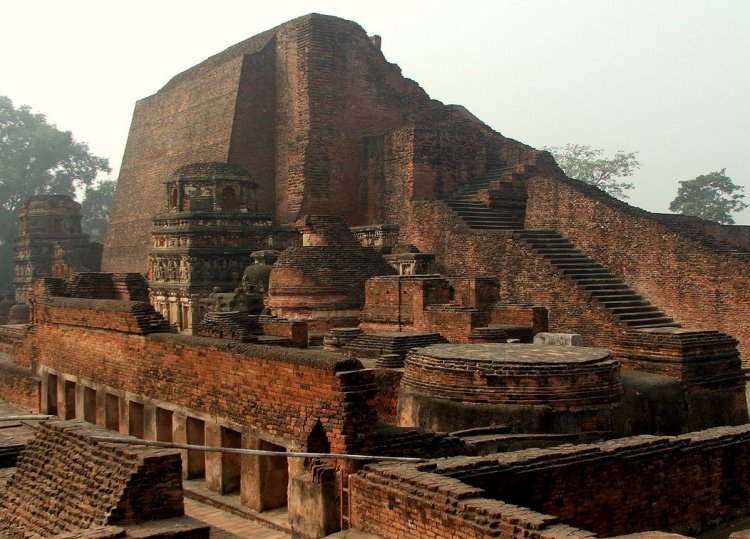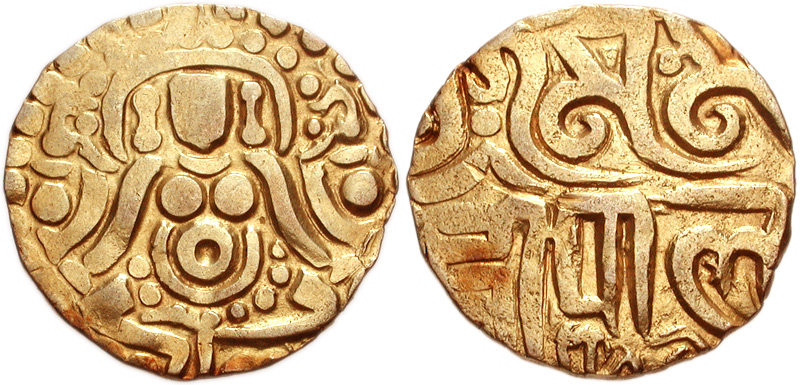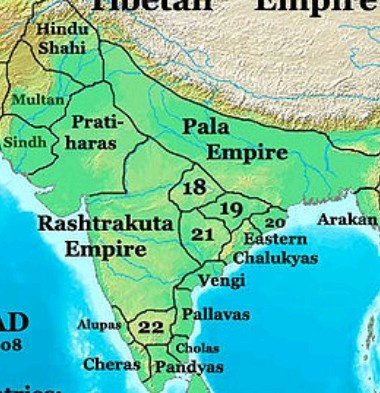- Home
- History of India
- Indian Dynasties
- Pala Dynasty
Pala Dynasty
Pala Dynasty:
Quick Facts:
Dynasty: Pala
Country: India
Ruled from: 8th Century to 12th century
Religion: Mahayana Buddhism, Tantric Buddhism and Shaivism
Preceded by: Gauda Kingdom and succeeded by Chero Dynasty and Sena dynasty.
Important Rulers are: Gopala (founder), Dharmapala, Devapala, Mahendrapala and many more
Introduction:
Pala
Empire ruled from 8th to 12th century and originated and
ruled parts of Bengal and Bihar of India. The founder of Pala Dynasty or Empire is Gopala, and the dynasty was existed for close to 400 years. The word Pala means
Protector and was used as suffix to the rulers of this dynasty. It meant the
ruler was the protector of the kingdom and the people. Some of the major cities
that Pala had control were Vikrampura, Pataliputra, Gauda, Monghyr, Somapura,
Tamralipta and Jaggadala. Pala’s were followers of Mahayana and Tantric school
of Buddhism. The rulers made some important contributions for the development
of Buddhism.
Geography of Pala Empire
Pala’s could not steadily maintain the geography and it kept on changing. Even though they conquered many parts in North India still could not maintain due to the constant attack from Gurjara Prathihara, Rashtrakutas or from other rulers.
There
is no exact evidence to show the geography of Pala, but it is believed that they
ruled the entire region of Bengal. The rulers kept on increasing the boundary
by defeating many rulers still no evidence is available in the history to show
the boundary.
Dharmapala
and Devapala who were the son and grand son of Gopala expanded the kingdom
extensively. Dharmapala was able to conquer Kannauj and other parts in North
India. Devapala defeated Utkala Kingdom of Orissa and took control on the place.
He also expanded to Assam and other parts. However after Devapala the Empire
started to disintegrate and lost many places which Devapala had conquered.
History and Origin of Pala Dynasty

Before
the Pala’s could take control over Bengal, the region of Bengal was experiencing
anarchy and confusion because of the death of Shashanka who was the ruler of
Gauda Kingdom. There was no central power and there was always fight among the
chieftains even to very minute issues.
People
of Bengal were suffering seeing the situation Gopala ascended the throne and
established Pala Dynasty/Empire. Gopala was democratically elected as the ruler
of political authorities. Thus Pala dynasty established and ruled for close to
400 years from 8th century to 12th century.
Not
much is known about the first Pala ruler Gopala. According to the Khalimpur
copper plate inscription it is believed Gopala was the son of the warrior named
Vapyata. It is also believed the Gopala was a Kshatriyas and was from Solar
dynasty. Gopala’s grandfather was considered as a very learned man and his
father was a very strong chief who defeated many enemies in the war field.
His
father’s name was Vapyata and his grandfather’s name is Dayitavishnu. It is
believed that Gopala was an ardent follower of Buddhism and is also credited
for construction of famous Buddhist monastery Odantapuri what is now known as
Bihar India. He died at the age of 80 after ruling for 27 years. His son
Dharmapala succeeded him and ruled from 770-810 AD.
When Dharmapala took over the Kingdom he had to face tough competition from Prathihara’s in the Northwest India and Rashtrakutas at the Deccan. Initially Dharmapala was defeated by the rulers Vatsaraja and Dhruva of Prathihara and Rashtrakuta. When Dhruva left to capture more places in Deccan, Dharmapala got busy with expanding his territories in North India.
He made the Pala’s a dominant and strong kingdom in North India.
He ruled over Bengal and Bihar and kept his nominee in Kannauj after defeating
Indrayudha of Kannauj. Dharmapala was defeated by Gurjara Prathihara twice and
each time Rashtrakuta’s in turn defeated the Prathihara’s. This helped the
Pala’s and made them the strong Kingdom of North India.
Dharmapala
was succeeded by his son Devapala. The Empire continued to further expand and
prosper under his rule. He was the most powerful king in the Pala dynasty.
Several Pala inscriptions also give credit for his work and military expansion.
Along with his cousin Jayapala Devapala did military expeditions which led to
the invasion of Pragjyotisha and Utkala which are present day Assam and Orissa.
He
was also a staunch believer in Buddhism and gave permission for constructing
temples and monasteries in Magadha. Devapala ruled for almost 40 years and with
his death there were no proper leaders to continue. Pala Empire started to
decline with the death of Devapala. Many rulers succeeded him but until Mahaipala
I who took control of Pala dynasty in 988 AD and started to revive the dynasty.
Pala Dynasty Administration

It was monarchical type of administration under Pala dynasty. It means that the King had all the powers and he was the head for all the departments. The Pala kings assumed high sounding titles like Parameshwara, Paramvattaraka and Maharajadhiraja. Prime Ministers were appointed by the King himself. Later on the post of Prime minister became hereditary. The line of Garga served as the Prime Minister of Pala’s nearly for 100 years.
The empire was divided into Bhuktis
and each Bhuktis were divided into Vishayas and Mandalas. It was further
divided into smaller units known as Khandala, Aviritti, Chaturaka and Pattaka.
This helped the Empire to take of the citizens and also for the development of
the Empire.
Among
these some of the main officers about whom there has been a mention in the
royal grants and inscriptions include Amatyas, Dutas, Dasgramikas, Grampatis,
Chauradharanikas, Dandikas, Dandisaktis, Senapati, Mahasenapati, Naukadhashyas,
Uparikas, Rajasthaniyas and many more.
Mahasenapati was the highest officer for the Pala military.
It was a fourfold army and consisted of infantry, cavalry, elephants and
Chariots. Pala’s has the largest war elephants while the Rashtrakutas had best
infantry. The Pala inscriptions on the copper
plates mentions the appointment of mercenary forces from kamboj, Kasa, Huna,
Malwa, Gujarat and Karnataka. The army was divided into Senapati, Mahasenapati,
Cavalry, soldiers, kottapala and Prantapala.
Pala Dynasty Culture
Pala’s
were followers of Mahayana Buddhism. The rulers of Pala did build many
monasteries like Odantapuri. It was built by the founder of Pala dynasty
Gopala. Dharmapala who was also the staunch follower of Buddhism made
Haribhadra as his spiritual leader. Dharmapala also established many monasteries
among them the famous ones are Vikramashila and Somapura Mahavihara.
Full
credit goes to Pala rulers for developing some of the important monasteries and
also Mahipala I ordered for the renovation and restructuring at Sarnath,
Nalanda and Bodh Gaya. They also developed Buddhist centres at Nalanda University
and Vikramashila. They also supported other religions in their kingdom.
Pala’s gave lot of importance for the development of education and literature in their kingdom. The Gauda style of literature developed during the Pala period. During Pala rule a mystical poems called as Charyapada developed immensely.
It was
written and composed by Abahatta and these songs of realisation, the Charyapada
was meant for singing. The original Charyapada has around 47 verses. The credit
for discovering and searching Charyapada goes to Haraprasad Shastri.
Some
of the other notable texts include Agama Shastra by Gaudapada, Nyaya Kundali by
Sridhar Bhatta, Sushrata by Gadadhara Vaidya.
Important Pala Rulers
Gopala
Founder of Pala dynasty
Ruled from 750-770 AD
Father Vapyata
Son Dharmapala
Religion
Follower of Buddhism
Dharmapala:
Second Ruler of Pala Dynasty
Ruled from 770 AD
Father
Gopala
Ruled present day Bengal and Bihar. He expanded the geography of Pala Empire to a very large extent. Dharmapala conquered Kannauj and kept one of his nominees Charkayudha to take care of the affairs in Kannauj.
This led to a
dispute between Dharmapala and Prathihara king Vatsaraja. In a fierce battle
that was fought near Prayag Dharmapala was defeated by Vatsaraja and lost the
place Kannauj. However, Vatsaraja was in turn defeated by Rashtrakuta king
Dhruva. Dharmapala again regained control on Kannauj but was defeated by
Dhruva.
Dharamapala always had difficulties with Gurjara Prathihara and Rashrakutas until the rulers of Rashrakutas moved towards Deccan. Dharmapala ruled closed to 40 years and was later on succeeded by his son Devapala.
He
was a follower of Buddhism and built many monasteries. He also helped in
reviving of Nalanda University and also founded Vikramshila university. There
are various epigraphs of the Dharmapala reign like Kesava prasasti, Khalimpur
Copper plate, Nalanda copper plate and many more.
Devapala:
He
was the third ruler and the most powerful ruler of Pala Dynasty. He succeeded
his father Dharmapala. Along with his cousin Jayapala, Devapala launched a
military campaign and conquered many places. One of the inscriptions on Badal
Pillar states that Devapala expanded his empire up to Vindyas and Himalayas. Other
than Bengal and Bihar he did conquer and ruled Assam and Orissa. Even Devapala
ruled for 40 years and was succeeded by Shurapala or Vigrahapala.
Even
Devapala was a staunch follower of Buddhism and has built many monasteries and
temples in Magadha. After the death of Devapala the Pala dynasty was under
decline until Mahaipala came and revived the dynasty.
Decline in Pala Dynasty
After
the death of Devapala all the rulers succeeded Devapala were weak rulers.
Narayanapala, his son Rajapala his son Gopala II proved to be weak rulers. They
lost most of the conquered places even Bengal and were left with only Bihar.
Vigrahapala II also had to bear and tolerate the invasions of Chandelas and
Kalachuris. During his period the Pala Empire was further broken into smaller
kingdoms like Gauda, Radha, Anga and Vanga.
It
was only when Mahipala I took over the reigns of Pala dynasty there was some
revival of the dynasty. He regained Bengal and other parts. During his period,
Mahipala I had to face constant threat from Chola dynasty ruler Rajendra Chola
I. Even with constant threat from Chola ruler Mahipala conquered back parts of
Bihar, Varanasi and the surrounding areas.
Nayapala
who was the son of Mahipala defeated Kalchuri son Karna after a long fight. The
two later signed a peace treaty. However there was constant pressure of Pala
rulers from Kalachuri King Karna until Vigrahapala III married Karna’s daughter
Yauvanasri.
Things were getting worst for Pala rulers. Vigrahapala III was defeated by Chalukya's. Mahipala II who succeeded Vigrahapala III was also short lived. The Pala dynasty further declined and finally after the death of Ramapala the dynasty was replaced by Sena Dynasty thus coming to an end of another huge and important dynasty.
Update on coronavirus in India
Affiliate Disclosure:
If you make any purchase via a link on this site, I may receive a small commission with no added cost to you.

























